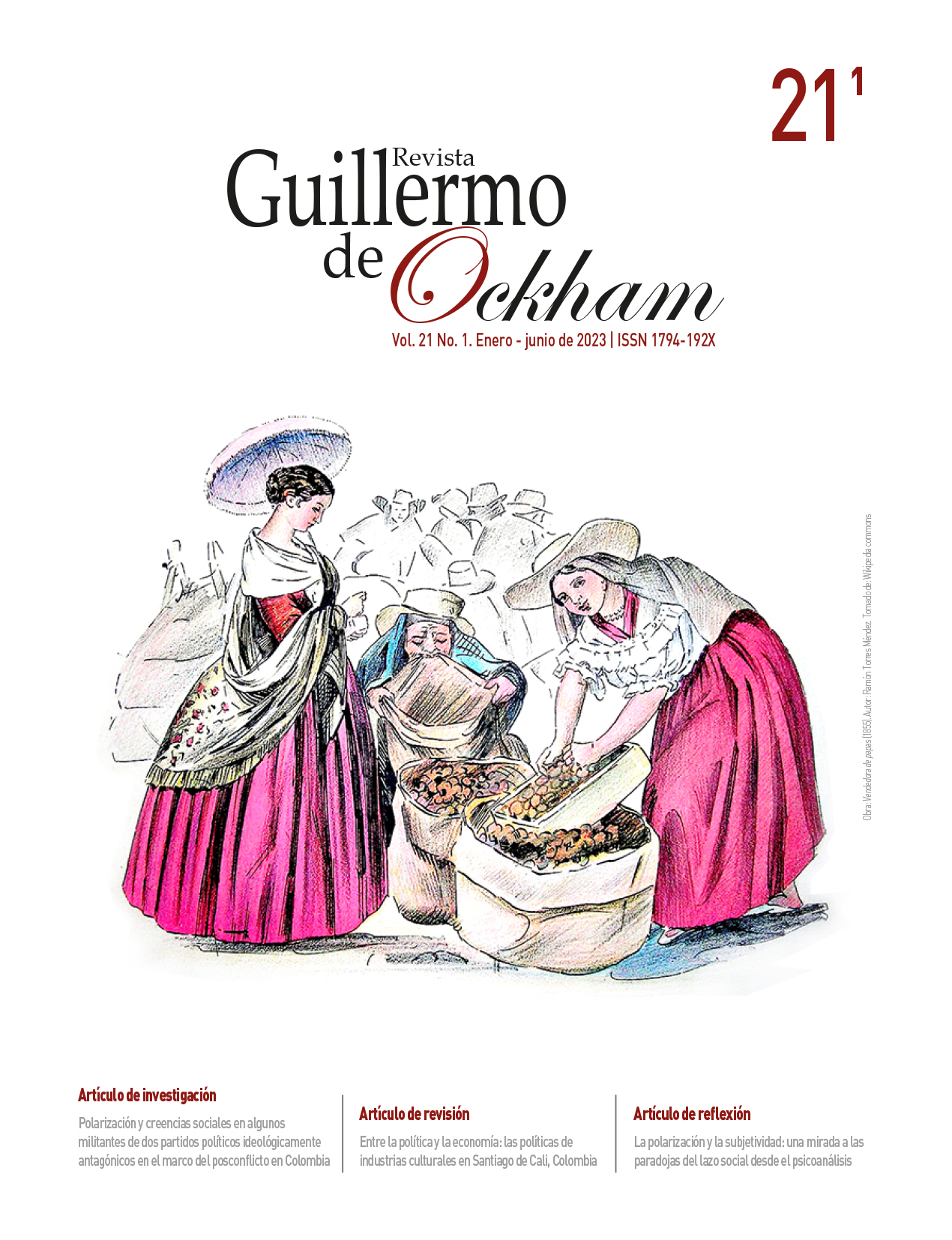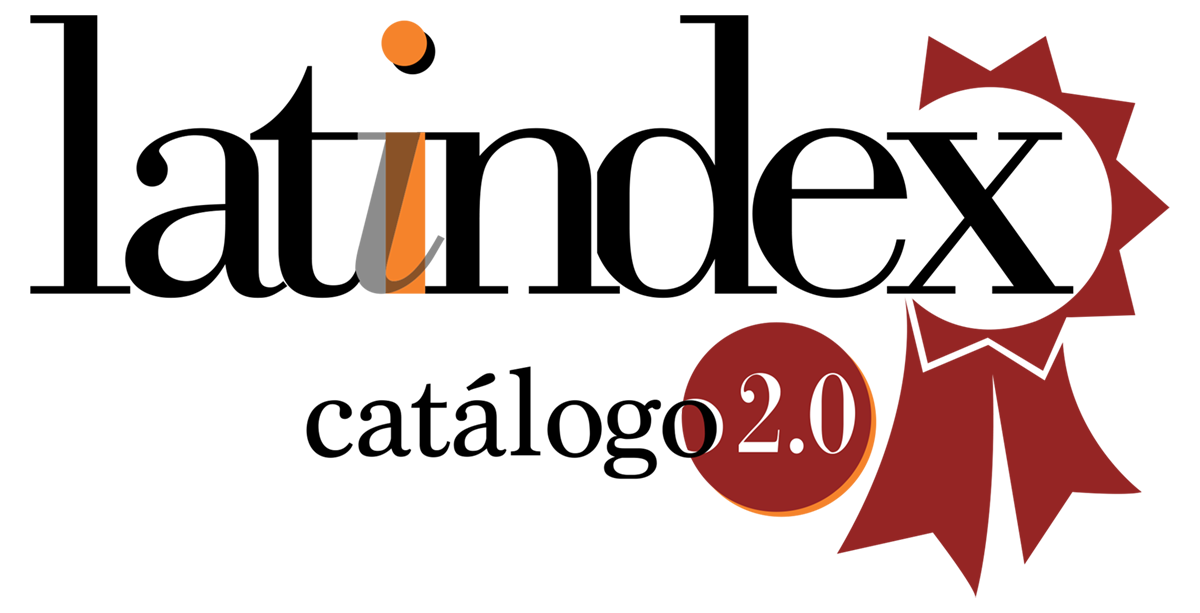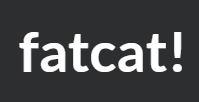The Revista Guillermo de Ockham provides an immediate and open access to its content, based on the principle of offering the public a free access to investigations to provide a global interchange of knowledge.
Unless otherwise established, the contents of this journal has a license with Creative Commons Attribution-NonCommercial-NoDerivatives 4.0 International (CC BY-NC-ND 4.0) http://creativecommons.org/licenses/by-nc-nd/4.0/
- Attribution: You must give appropriate credit, provide a link to the license, and indicate if changes were made. You may do so in any reasonable manner, but not in any way that suggests the licensor endorses you or your use.
- NonCommercial: You may not use the material for commercial purposes.
- NoDerivatives: If you remix, transform, or build upon the material, you may not distribute the modified material.
- No additional restrictions: You may not apply legal terms or technological measures that legally restrict others from doing anything the license permits.
Abstract
This article will try to answer whether the graphic novel Los once, by Jiménez et al. (2014), gathers the essential points to consider it an example of minor literature, in accordance with the proposal of Gilles Deleuze and Félix Guattari. To do this, we will start from three moments: one that establishes, in a general way, the basic characteristics of the graphic novel, and in which a brief definition of this is proposed, based on the discussion about its presumed difference with the comic, thus as its validity as an object of philosophical study. In a second moment, some key points about minor literature will be presented, according to Deleuze and Guattari, to later end, in a third moment, with the analysis of the mentioned graphic novel, which gives an answer to the question about its possibility as minor literature and its importance for understanding the Colombian armed conflict. A methodology of textual analysis has been followed both by the aforementioned authors and other experts on the subject, with which a conceptual framework has been obtained that validates the hypothesis on the inclusion of the graphic novel analyzed as minor literature, with which it is concluded, on the one hand, the importance of the approach to literature from this perspective, for the study of complex social phenomena –in this case, the Colombian armed conflict– and on the other, the importance of the comic or graphic novel as a means of expression in a society.
Keywords:
References
Alías, A. J. (2010). La confabulación de Gilles Deleuze y Félix Guattari: escritura literaria contra flujos de poder. Sociocriticism, 25, 353-365.
Altarriba, A. (2008). La historieta: un medio mutante. Quimera, (293), 48-55.
Álvarez, E. (2008, 29 de abril). Tensiones entre filosofía y literatura: la escritura como práctica de una nueva imagen del pensamiento en Gilles Deleuze [Ponencia]. XLV Congreso de Filósofos Jóvenes, Granada, España. https://cfj.filosofia.net/2008/textos/filosofia_literatura.pdf
Bajtín, M. (1989). Teoría y estética de la novela. Taurus.
Barbieri, D. (1998). Los lenguajes del cómic. Paidós.
Barrero, M. (2012). De la viñeta a la novela gráfica: un modelo para la comprensión de la historieta. En A. M. Peppino (Coord.), Narrativa gráfica: los entresijos de la historieta (pp. 29-60). Universidad Autónoma Metropolitana.
Barrero, M. (2013). La novela gráfica: perversión genérica de una etiqueta editorial. En J. M. Trabado Cabado (Comp.), La novela gráfica: poéticas y modelos narrativos (pp. 191-224). Arco.
Baur, E. K. (1978). La historieta como experiencia didáctica. Nueva Imagen.
Beaty, B. (2009). Autobiography as authenticity. En J. Heer y K. Worcester (Eds.), A comics studies reader (pp. 226-235). University Press of Mississippi.
Benot, C. (1978). El dibujo como elemento de expresión en el cómic. Cauce, (1), 165-171. https://cvc.cervantes.es/literatura/cauce/pdf/cauce01/cauce_01_011.pdf
Beraldi, G. (2013). Literatura y filosofía: la literatura como problema en Deleuze o la escritura como phármakon. Eikasia: Revista de Filosofía, (49), 163-176.
Bobes, M. C. (1998). La novela. Síntesis.
Bourneuf, R., y Ouellet, R. (1985). La novela. Ariel.
Chirolla, G. (2010). Política de una trenodia audio visual. Kepes, 7(6), 175-194. https://revistasojs.ucaldas.edu.co/index.php/kepes/article/view/487
Cohn, N. (2007). The visual language manifesto: Restructuring the “comics” industry and its ideology (2.a ed.). Visual Language Lab. http://www.visuallanguagelab.com/P/vlmanifesto.pdf
Coma, J. (1979). Del gato Félix al gato Fritz: historia de los cómics. Gustavo Gili.
Dahrendorf, M. (1977). Comics in der Schule: Ein Unterrichtsmodel. En W. J. Fuchs (Ed.), Comics (pp. 149-162). Leske Verlag + Budrich GmbH.
Deleuze, G. (1989). Lógica del sentido. Paidós.
Deleuze, G. (1995). Proust y los signos (3.ª ed.). Anagrama.
Deleuze, G. (1996). Crítica y clínica. Anagrama.
Deleuze, G., y Guattari, F. (1978). Kafka: por una literatura menor. Era.
Deleuze, G., y Guattari, F. (1994). Mil mesetas. Pretextos.
Dittmar, J. F. (2011). Comic-analyse. UVK.
Dorfman, A., y Mattelart, A. (2002). Para leer al Pato Donald. Siglo XXI.
Eco, U. (1984). Apocalípticos e integrados. Lumen.
Eisner, W. (1998). La narración gráfica. Norma.
Eisner, W. (2002). El cómic y el arte secuencial. Norma.
Etchegaray, R. (2015). Deleuze y el pensamiento de la sensación. Nuevo Pensamiento, 5(5), 1-26. http://www.editorialabiertafaia.com/nuevopensamiento/index.php/nuevopensamiento/article/view/97/71
García, S. (2010). La novela gráfica. Astiberri.
García Peinado, M. Á. (1998). Hacia una teoría general de la novela. Arcos Libros.
Giofkou, D. (2015). Writer as an acrobat: Deleuze and Guattari on the relation between philosophy and literature (and how Kierkegaard moves in-between). Transnational Literature, 7(2), 1-10.
Gómez Salamanca, D., y Rom Rodríguez, J. (2012). La novel·la gràfica: un canvi d’horitzó en la indústria del còmic. Ítaca: Revista de Filologia, (3), 35-65. http://dx.doi.org/10.14198/ITACA2012.3.02
Gubern, R. (1987). La mirada opulenta: exploración de la iconosfera contemporánea. Gustavo Gili.
Hinojosa, F. (1978). Por una literatura menor. Revista de la Universidad de México, 6, 33-35.
Jiménez, D. (2014). Páginas en emergencia: un itinerario de la novela gráfica en Colombia. Boletín Cultural y Bibliográfico, 48(86), 1-10. https://publicaciones.banrepcultural.org/index.php/boletin_cultural/article/view/7524
Jiménez, M., Jiménez, J., y Cruz, A. (2014). Los once. Laguna Libros.
Kundera, M. (2006). El arte de la novela. Tusquest.
Macherey, P. (2003). ¿En qué piensa la literatura? Siglo del Hombre.
Maldonado, J. F., Palencia, M. A., y Silva, A. (2015). Deleuze y la novela corta: las líneas de vida en “El último pecado”. Revista Filosofía UIS, 14(1), 169-185. https://doi.org/10.18273/revfil.v14n1-2015008
Maldonado, J. F., Palencia, M. A., y Silva, A. (2016). Literatura menor en Tirano Banderas desde la propuesta de lectura filosófica de la novela de G. Deleuze y F. Guattari. Revista Filosofía UIS, 15(2), 157-179. https://revistas.uis.edu.co/index.php/revistafilosofiauis/article/view/6237
Martín, A. (1978). Historia del cómic español: 1875-1939. Gustavo Gili.
McCloud, S. (2005). Entender el cómic: el arte invisible. Astiberri.
Mejía, P. (2001). Semiótica del cómic. Instituto Departamental de Bellas Artes.
Moreno, G. (2016). La novela gráfica en Colombia: arte y memoria para el postconflicto. Creación y Producción en Diseño y Comunicación, 13(76), 14-18. https://fido.palermo.edu/servicios_dyc/publicacionesdc/archivos/630_libro.pdf
O’Sullivan, S. (2005, octubre). Notes toward a minor art practice. https://www.simonosullivan.net/articles/minor-literature.pdf
Paramio, L. (1971). El cómic y la industria cultural. Estudios de Información, 19-20, 169-194.
Peppino, A. (2012). La mirada opulenta. En A. M. Peppino (Coord.), Narrativa gráfica: los entresijos de la historieta (pp. 16-26). Universidad Autónoma Metropolitana.
Perdomo, O. (2015). Cimarronaje en el cómic. Nexus Comunicación: Revista de Comunicación Social, (18), 46-69. https://doi.org/10.25100/nc.v0i18.679
Pociask, J. (2015). Multikodale Gestaltung von Comics. Text und Discurs, 8, 77-89.
Rodríguez, J. C. (1995). Literatura y filosofía: Deleuze o la caza del Snark. La balsa de la Medusa, (36), 53-56.
Sabin, R. (1996). Comics, comix and graphic novels: A history of comic art. Phaidon Press.
Souto, L., y Martínez Rubio, J. (2016). Perspectivas, toma de conciencia y consolidación de la historieta en el mundo académico. Diablotexto Digital, 1, 1-5. https://doi.org/10.7203/diablotexto.1.9033
Trabado Cabado, J. M. (2012). Construcción narrativa e identidad gráfica en el cómic autobiográfico: retratos del artista como joven dibujante. Rilce: Revista de Filología Hispánica, 28(1), 223-256. https://doi.org/10.15581/008.28.2997
Wertham, F. (1954). Seduction of the innocence. Rinehart & Company.

































